http://www.duncanpickstock.co.uk/
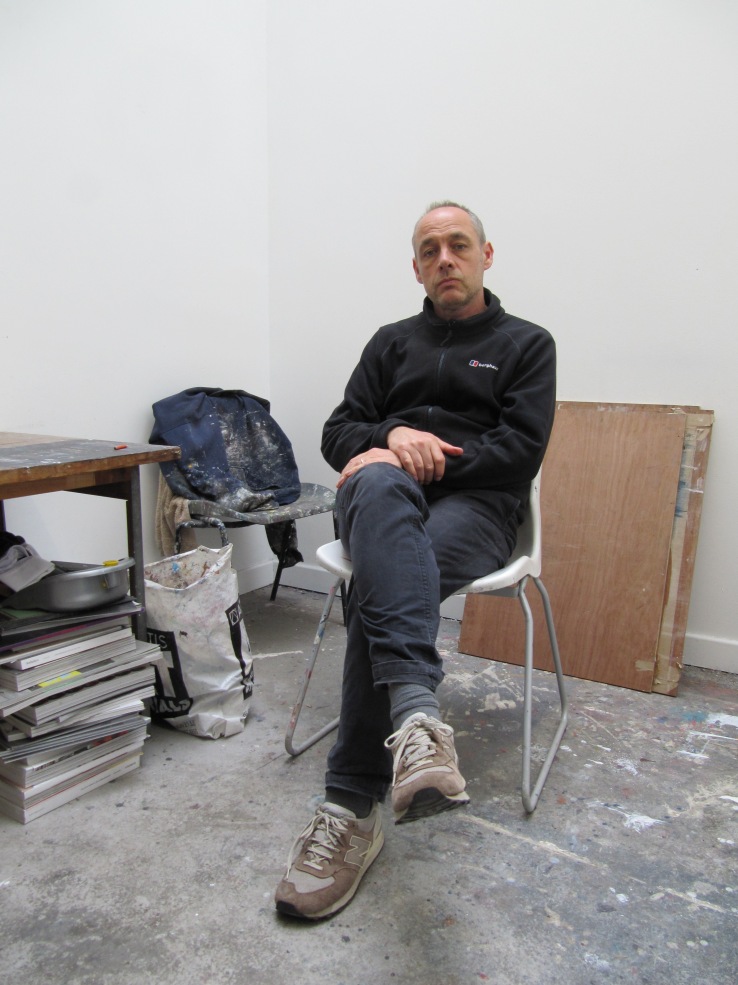 The brooding presence of the abandoned glass and concrete Lesney ‘Matchbox’ factory[1] stood on the banks of the river Lea opposite Hackney Marshes in east London until 2012. A multi-storey glass, brick and concrete complex, built in the 1960s to house one of the three globally dominant British die-cast toy manufacturers, it functioned as a world-leader from this base for almost twenty years until the fashion for small metal cars suddenly faded and the company went bankrupt in the 1980s. No trace of the industrial architecture and the flow of materials through its riverside goods-truck docks remains, and on the site now stands a towering glass and multi-coloured cladding apartment block development. Just as its quaint marketing-friendly new name – Matchmaker Wharf – disguises its true industrial heritage, the uniformly well-maintained facade also hides 49
The brooding presence of the abandoned glass and concrete Lesney ‘Matchbox’ factory[1] stood on the banks of the river Lea opposite Hackney Marshes in east London until 2012. A multi-storey glass, brick and concrete complex, built in the 1960s to house one of the three globally dominant British die-cast toy manufacturers, it functioned as a world-leader from this base for almost twenty years until the fashion for small metal cars suddenly faded and the company went bankrupt in the 1980s. No trace of the industrial architecture and the flow of materials through its riverside goods-truck docks remains, and on the site now stands a towering glass and multi-coloured cladding apartment block development. Just as its quaint marketing-friendly new name – Matchmaker Wharf – disguises its true industrial heritage, the uniformly well-maintained facade also hides 49 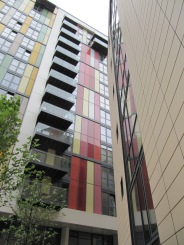 artists’ workspace units, part funded by an Arts Council scheme[2] and managed by the Acme Studios[3] organisation.
artists’ workspace units, part funded by an Arts Council scheme[2] and managed by the Acme Studios[3] organisation.
A concierge directs me to the studios’ discrete entrance door and its minimalist entry-phone. I’ve come here to meet the painter Duncan Pickstock, an artist I met several years ago while we were both renovating and decorating a new gallery space near Spitalfields[4]. The moment the buzzer goes and I enter the lobby the stripped-back industrial-aesthetic corridors tell me this is still a place where stuff gets made. The commodity homes above already feel a world away.
Duncan’s studio is a typical unit measuring approximately 4m x 4.5m in plan. A fat ‘L’ shape in side elevation, the first half of the space has a ceiling height of approximately 3m. This opens up into a light well in the second half approximately 4m tall providing an 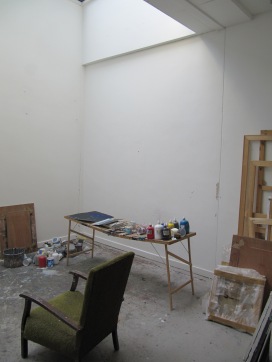 impressive working wall roughly 4m wide by 4m high of smooth plaster lit evenly by overhead windows. The other walls are also smooth plaster, all of them are painted white. The floor is plain board and covered in the typical drips and spills from a working painter’s studio. A couple of fluorescent strips augment the lighting in the lower half of the space, while running water and cleaning facilities are provided in a shared sink area down the corridor.
impressive working wall roughly 4m wide by 4m high of smooth plaster lit evenly by overhead windows. The other walls are also smooth plaster, all of them are painted white. The floor is plain board and covered in the typical drips and spills from a working painter’s studio. A couple of fluorescent strips augment the lighting in the lower half of the space, while running water and cleaning facilities are provided in a shared sink area down the corridor.
Showing me round, Duncan stresses how much he likes the design of the studio. “There’s no wasted space,” he says pointing out that every centimetre of wall space is functional, there are no distracting eye-level windows or breaks in the walls for trunking, pipes or structural pillars. The studio is also relatively free of furniture: a workbench; a small shelf unit; an upholstered armchair and a plastic stacking chair; a decorator’s collapsible table and a dog’s bed (with patiently snoozing dog) are the only items in the room but everything feels purposeful and ready to use. Opposite the working wall, neatly stacked in the corner, is a large collection of finished canvas paintings and stretchers extending at least a metre into the space. Books and tools are loosely stored and arranged under the worktable and 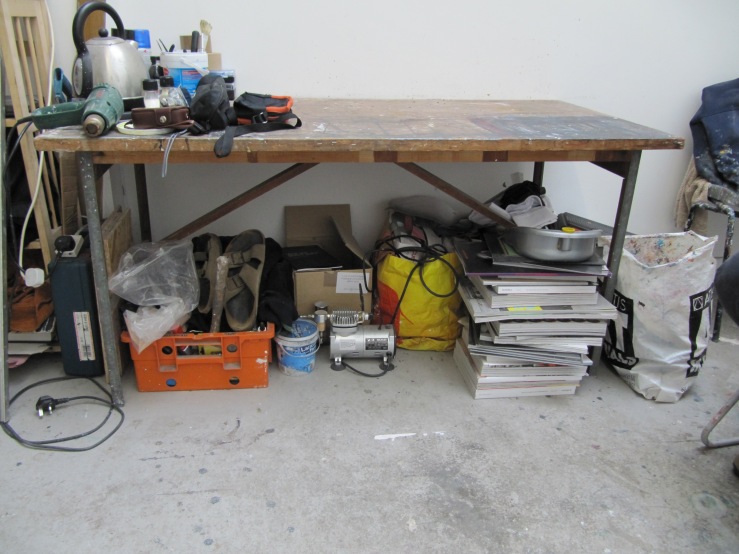 on the shelves, along with a microwave oven, a kettle and some mugs and teabags.
on the shelves, along with a microwave oven, a kettle and some mugs and teabags.
The decorator’s table sags characteristically in the middle, more by its design than the weight of the acrylic paint bottles (mostly 500ml), assorted brushes and works on paper that lie across it. On the floor around it are more paints in bottles and an assortment of containers (plastic yoghurt tubs) some of which are upturned against the wall to support one of three A1 sized drawing boards which are in various stages of use with stretched paper.
In terms of routine Duncan is currently able to get to the studio most days: four or five per week. This involves a journey, accompanied by his dog, from north London ending at the nearby Overground train station. His studio activity feels highly self-contained: all work is done in the studio. No sketches or studies are brought in to work on from outside, no work is taken home. The empty walls of the studio bear this out – there are no ‘studies’ pinned up, no preparatory works, and there are only a handful of tiny images in the corner of the room which seem to represent random ‘likes’ rather than 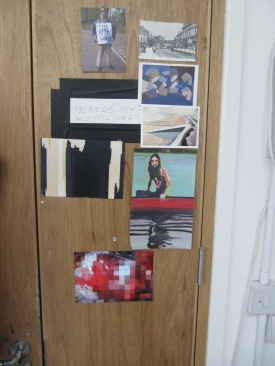 reference material (a few cuttings and cards including a Nash[5], a Peter Doig[6], a Clyfford Still[7], and an early 20th C. Picture of Homerton station). Of working he says, “You just come in – it depends what stage the things you’re working on are at – you look at them and you try to resolve the problems you’ve got with them.” To do this Duncan has no elaborate process or set-up. Paints are mixed into individual pots rather than on a palette. There are “no strategies” – no essential materials or must-have brands – and his attitude to colours is relaxed and un-precious; they’re simply “colours that I’ve got – mix ‘em up – pick them off the shelf at Atlantis (Art Supplies)[8].”
reference material (a few cuttings and cards including a Nash[5], a Peter Doig[6], a Clyfford Still[7], and an early 20th C. Picture of Homerton station). Of working he says, “You just come in – it depends what stage the things you’re working on are at – you look at them and you try to resolve the problems you’ve got with them.” To do this Duncan has no elaborate process or set-up. Paints are mixed into individual pots rather than on a palette. There are “no strategies” – no essential materials or must-have brands – and his attitude to colours is relaxed and un-precious; they’re simply “colours that I’ve got – mix ‘em up – pick them off the shelf at Atlantis (Art Supplies)[8].”
What is a priority, though, is the engagement with the process of what paint does when you use it. A recent residency in rural west Ireland has prompted a shift to working on paper in acrylics. “I started using acrylic because the drying time with the oil paint I used to use was prohibitive,” he explains. Several times Duncan talks about making ‘pictures’ and although highly abstracted, the images being worked on around the room at the 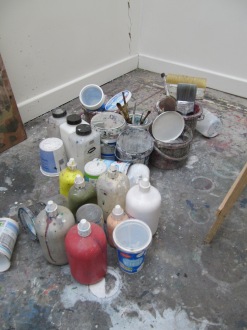 moment involve a tension between abstraction on a surface and depth on a picture plane. If there is a hint of landscape in the works in progress it is not conscious inspiration. “Sometimes you see something,” he says reflecting on the landscape qualities. “Often you see something that corresponds to what you’re looking for [in the studio] rather than coming on you by surprise.”
moment involve a tension between abstraction on a surface and depth on a picture plane. If there is a hint of landscape in the works in progress it is not conscious inspiration. “Sometimes you see something,” he says reflecting on the landscape qualities. “Often you see something that corresponds to what you’re looking for [in the studio] rather than coming on you by surprise.”
The materials in the workspace seem to set the parameters for the focus of and output from any studio activity. Although the Irish landscape may or may not have had a subconscious impact, Duncan’s conscious engagement is almost entirely with the materials and processes of inventing and making ‘pictures’ in the studio. Although he closes the door on ‘work’ when he leaves the studio that’s not an end to thinking about it. “The questions are always there,” he says “You’re pondering stuff – what has been successful, what hasn’t been successful. It’s always in your mind.” Sometimes activities or work equipment from outside the studio have an impact. Acrylics present certain problems of ‘finish’ and among the selection of artists’ brushes on the decorator’s table are a few expensive synthetic decorator’s brushes (around 5cm/2” in size). “Purdy’s[9] are fantastic for doing big sheens, big areas,” he explains. “Using acrylics, to stop it being dead, you have to do lots of thin layers and you have to brush them out, so I’ve got a very big varnishing brush down there that I use quite often,” he says pointing to a wide soft brush. “You use things, you see what they can do – you learn what they can and can’t do – then you just get on with it,” he tells me. A collection of tools in the studio illustrates the point: a small abandoned airbrush compressor sits under the table (“not heavy duty enough”), and an electric hot-air paint-stripper is kept handy to help with drying times. But apart from the small images pinned on the wall there is no evidence of the outcome of thinking time outside in any material form; nothing within the studio implies external visual sources being brought in to work on. He remembers a quote from Diebenkorn[10], “Painting is about 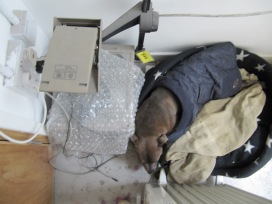 setting problems for yourself and then solving them,” before adding “and that’s what’s engaging.”
setting problems for yourself and then solving them,” before adding “and that’s what’s engaging.”
The day in the studio is usually interrupted around lunchtime to take the dog for a walk on nearby Hackney Marshes. Sometimes there’ll be a break for a visit to or from other artists in the studio complex. A pile of catalogues under the solid work table suggests a busy programme of gallery visits, but these are a red herring – a collection of arbitrarily acquired catalogues used as raw material in a period of work which experimented with collage. Though he never buys catalogues, he is a frequent gallery-goer, usually setting aside time every couple of weeks to go to see shows. “I like going to see what’s on,” he asserts, countering my notion that going to galleries regularly might involve some sort of discipline. “You hope you’ll see something amazing. 95% of the time you don’t but every so often you do and that’s an amazing thing,” he says, and adds that a recent visit to a Picasso show at the Gagosian[11] had the desired payoff. “There was a painting I’d never seen before and it was absolutely amazing.”
Outside the studio, Duncan makes short video projects which also populate his website. These are shot outside the studio and edited at home on computer. There’s a clear split between the videos and painting. “When I started making films it was an important thing for me to do in terms of making paintings,” he explains. “I was frustrated that I was unable to explore my political and social anger in my work, because I don’t think you can in painting – or at least I certainly can’t. Making films allows me to address these very specific things in a more direct way and so that takes the pressure off the painting, really.”
The self-contained nature of the studio work leads me to ask if the process is a bit hypnotic: if he becomes lost in the activity, free as it is from direct external sources. There are no distractions inside the studio either – no music player, no radio. Is there some sort of monkish, hermit-like meditation going on? “That’s a bit fucking transcendental,” he replies. “No, you’re just doing work aren’t you. You have an idea about where you want to get to because you’re familiar with your practice and you think you’ll try ‘this’ and ‘this’ and ‘this’ll work nicely.” For Duncan, the process is clear and direct. “The marks that you make and the responses those marks require; that’s the whole process of painting. That’s what you’re engaged with.” Sounds simple, but he 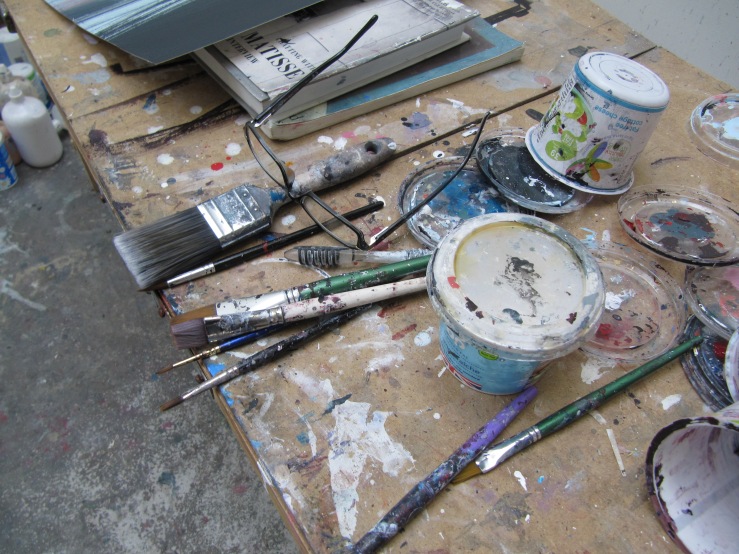 pauses to reflect on the difficulties. “Painting’s really hard,” he says and then adds to the statement: “Painting is a simple idea that’s very difficult to do, isn’t it. You know, sometimes it’s going well and that’s fantastic and the next day you come in and you think ‘what a load of fucking shit’, even though you might be looking at the same thing that you thought was fantastic just the other day.”
pauses to reflect on the difficulties. “Painting’s really hard,” he says and then adds to the statement: “Painting is a simple idea that’s very difficult to do, isn’t it. You know, sometimes it’s going well and that’s fantastic and the next day you come in and you think ‘what a load of fucking shit’, even though you might be looking at the same thing that you thought was fantastic just the other day.”
None of the finished works have allusive or descriptive titles. “With each painting that you start, with the marks that you make, you’re trying to take that to a resolution: where it’s complete.” If a work succeeds on some level it is given a date and number, like an entry on a slate which marks the attempt at finding solutions and registers the point of departure for the next. “If you work, most of the time things aren’t successful and they don’t get where you want them to. And then every so often there’s a little chink of light and you think maybe that’ll work, maybe that’ll be… And so you think, let’s work on that a bit. It informs the next thing. It always informs what’s coming next.”
There’s more stuff to be made.
GJ July.2017
http://www.duncanpickstock.co.uk/
All photographs © 2017 Graham Johnston
[1] Lesney Factory: http://www.matchboxmemories.com/Lesney%20History/lesney_history.htm
[2] Arts Council England’s Grants for the arts – capital programme
[3] Acme http://www.acme.org.uk/studios/matchmakerswharf
[4] Raven Row: http://www.ravenrow.org/
[5] Paul Nash: http://www.tate.org.uk/art/artists/paul-nash-1690
[6] Peter Doig: https://en.wikipedia.org/wiki/Peter_Doig
[7] Clyfford Still: https://clyffordstillmuseum.org/clyfford-still/
[8] Atlantis Art Materials: http://www.atlantisart.co.uk/
[9] Purdy Brushes: http://www.purdy.com/
[10] Richard Diebenkorn: http://diebenkorn.org/
[11] Gagosian: http://www.gagosian.com/exhibitions/picasso-minotaurs-and-matadors–april-28-2017
